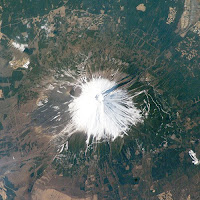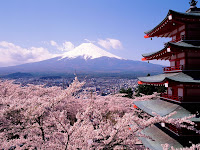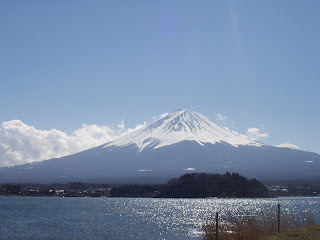 Mount Fuji (Fujisan) is with an altitude of 93776 meters is Japan's highest mountain. Mount Fuji is a dormant volcano, which most recently erupted in 1708. It stands on the border between Yamanashi and Shizuoka Prefectures and can be seen from Tokyo and Yokohama on clear days. It is located near the Pacific coast of central Honshu. Mount Fuji is surrounded by three small - Gotemba (East), Fuji-Yoshida (North) and Fujinomiya (Southwest).
Mount Fuji (Fujisan) is with an altitude of 93776 meters is Japan's highest mountain. Mount Fuji is a dormant volcano, which most recently erupted in 1708. It stands on the border between Yamanashi and Shizuoka Prefectures and can be seen from Tokyo and Yokohama on clear days. It is located near the Pacific coast of central Honshu. Mount Fuji is surrounded by three small - Gotemba (East), Fuji-Yoshida (North) and Fujinomiya (Southwest).Mount Fuji is an attractive volcanic cone and a well-known symbol of Japan. It is frequently depicted in art and photographs, as well as visited by sightseers and climbers.

The volcano is currently classified as active with a low risk of eruption but recently it is said to be dormant. The last recorded eruption occurred in 1707 during the Edo period. The volcano rises about 3,500 m above the surrounding plain. Fuji has erupted at least 16 times since 781 AD.

Today, it is a popular tourist destination and common destination for mountain-climbing.
A frequent subject of Japanese art, the most renowned work is Ukiyo-e painter Hokusai's masterpiece 36 Views of Mount Fuji. It is also mentioned in Japanese literature throughout the ages and the subject of many poems. It is not surprising that the nearly perfectly shaped volcano has been worshipped as a sacred mountain and experienced big popularity among artists and common people.
Mount Fuji is the archetype of the strato volcano and has only Mount Vesuvius as its rival as the best-known volcano.
However, there were many superstitions regarding Mount Fuji and women were prohibited from climbing it. People consider themselves very lucky while climbing it. It is also lucky for them if they can get a clearer view of the mountain because most of the time the snow covered peak is hidden by clouds or fog.
